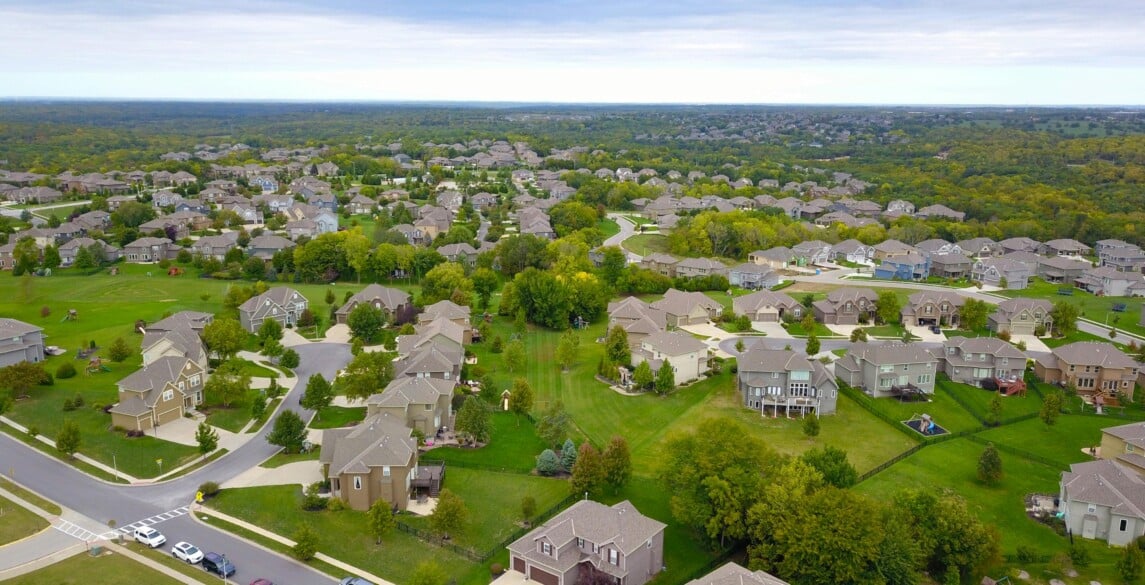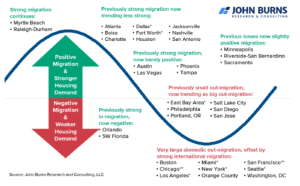From Cities to the Sunbelt: Where Are People Moving in the U.S. in 2024?
Where and why people move continues to shift since the pandemic. Growing mid-sized cities, cost of living, quality of life and remote work opportunities all impact migration trends in 2024.

The landscape of American migration is constantly evolving. From the rise of remote work to the desire for a better quality of life, various factors influence where people choose to live, work and raise their families every year.
Whether it’s the warm allure of the south, affectionately known as the Sunbelt, or the vibrant life and opportunities of urban centers, these trends are reshaping the real estate landscape. In this blog post, we’ll explore the key factors influencing migration patterns, analyze emerging trends and discuss the impact on the real estate market.
Key Factors Influencing Migration Patterns
Migration trends are influenced by a complex mix of economic, social and environmental factors.
Economic Opportunities
One of the primary drivers of migration is the availability of job opportunities. Regions with robust job markets tend to attract more people. In 2024, growing tech hubs like Austin, Texas and Raleigh, North Carolina continue to draw professionals looking for high-paying jobs in dynamic industries.
As job markets in mid-size, less expensive cities grow, there’s less of a reason for people to stay in traditional economic centers like New York City and San Francisco. The rise of remote work further gives people the flexibility to make economic decisions outside of physical limitations.
Cost of Living
The cost of living remains a critical factor in migration decisions.
States with affordable housing, lower taxes and overall lower living expenses are becoming increasingly attractive. The cost and ease of buying a home is a significant consideration for potential movers. The kind of home and space you are able to afford is also reliant on the real estate market you are entering; for example, what you may be able to afford in New York City will be drastically different from what you are able to afford in a smaller city like Greenville, South Carolina. If homebuyers are looking for more space, perhaps in the name of raising a family, they may opt to move outside of metropolitan centers.
Quality of Life

Quality of life encompasses various aspects, including climate, healthcare, education and recreational opportunities. The appeal of a balanced lifestyle – with scenic landscapes, outdoor activities and a sense of community – cannot be underestimated.
Proximity to family is another crucial element. Many people prefer to live closer to their loved ones, especially for families in need of childcare support or in times of uncertainty. These trends was particularly noticeable during the COVID-19 pandemic when family bonds became even more significant.
The Aftermath of the COVID-19 Pandemic
The pandemic has had a lasting impact on where people choose to live. Remote work has given employees the freedom to relocate without changing jobs. With the ability to work from anywhere, many people seized the opportunity to move closer to family or to places that offered a better lifestyle. This flexibility has led to a notable exodus from crowded downtowns and high-cost areas to more affordable and spacious suburban or rural areas.
Additionally, the pandemic’s impact on families has shifted preferences regarding in-home features. There is a growing desire for homes with dedicated office spaces and larger yards, as people seek properties that cater to their new lifestyles.
2024 U.S. Migration Trends
Understanding the latest migration trends can provide valuable insights for prospective homebuyers, real estate enthusiasts, urban planners, employers and more. While the pandemic drastically impacted where and why people move, five years later, we’re seeing a slight slowdown in the migration surge. While low supply and affordability keep many people in their current homes, every year there are a few key trends which drive the market.
Where People are Going and Leaving
Certain states are witnessing a significant influx of new residents, including Texas, Florida, North Carolina and South Carolina. These states offer a combination of economic opportunities, affordable living and favorable climates.
Conversely, states like California, New York and Illinois are experiencing outmigration. High living costs, taxes and changing job markets are prompting residents to seek greener pastures elsewhere.
John Burns Research & Consulting recently broke down the latest “winners and losers” among large markets:

The Allure of the South
The Sunbelt, particularly the southeast, has welcomed a growing number of new residents for decades with appealing warmer climates and new business hubs. However, the biggest shift for migration in the south coming out of the pandemic was more economic. According to a recent Bank of America report, people from expensive markets on the West Coast are leading the charge to more affordable housing opportunities.
Lifestyle changes, including the desire for larger homes and more outdoor space, are also driving people to the Sunbelt. The region offers a more relaxed pace of life, complemented by affordable housing and a lower cost of living, making the region an ideal choice for those looking to balance work and leisure in a pleasant environment.
Between April 2020 and July 2023, the South’s population increased by 3.9 million people. Cities in Florida and Georgia, and Texas cities like Austin and San Antonio, have seen major spikes in population. This trend has continued into 2024.
Suburban and Rural Growth
One notable trend in recent years is the shift of population growth from urban to suburban and rural areas. Cities like New York and Los Angeles are experiencing outmigration as residents seek less densely populated regions. Suburbs and smaller towns are becoming more attractive due to their affordability, safety and quality of life.
In 2024, as some offices mandate a return to work and urban planners breathe new life into downtowns, there’s growing interest in affordable areas right outside major metros. People are more willing to commute further to work to accommodate new lifestyle preferences.
Small- to Mid-Sized Cities Thrive
Not all urban areas are seeing a decline. While downtowns across the nation initially saw a decline in population, there has been a resurgence as offices reopen and the appeal of urban living returns. Cities like Raleigh, Orlando, Denver and Nashville are experiencing population growth due to their vibrant economies, cultural amenities and outdoor activities. These mid-sized cities offer a balance between urban opportunities and quality of life.
The convenience of city life, combined with the concentration of high-paying jobs, is drawing people back to metropolitan areas, creating a dynamic and competitive real estate market in small- to mid-sized cities.
Impact on Real Estate Market
Migration trends have a profound impact on local real estate markets. From driving up prices to the relationship between demand and inventory, moving preferences have a ripple effect.
High demand for housing in popular states like Texas and Florida is leading to limited inventory and higher price tags. This scarcity is creating a competitive market, with homes selling quickly and often above asking price. For potential homebuyers, this means acting fast and being prepared for bidding wars.
In states with declining populations, there may be a surplus of homes on the market. This situation can benefit buyers, who may find better deals and less competition.
The types of properties in demand are also changing. In the Sunbelt, there is a high demand for single-family homes with ample space and outdoor amenities. In contrast, urban areas are seeing increased interest in apartments and condos, specifically rentals, reflecting the lifestyle preferences of city dwellers who prioritize convenience and accessibility.
Urban Planning, Infrastructure & Business Decisions
Adapting to evolving migration patterns is crucial for urban planners, real estate developers and businesses to keep up with growing demand and population needs while attracting and retaining new residents.
Adapting to Growth
Cities experiencing population growth must invest in infrastructure to support their expanding communities. This includes improving transportation networks, expanding healthcare facilities and ensuring access to quality education. Issues such as water scarcity, increased traffic and strain on public services must be addressed to ensure the region can accommodate growth without compromising quality of life.
Strategies to Attract Residents & Employees
States and cities facing outmigration are implementing strategies to attract and retain residents. Tax incentives, job creation initiatives and quality of life improvements are some of the approaches being used. For instance, states like North Dakota and Indiana are focusing on creating business-friendly environments to draw new residents and businesses.
Urban areas face their own set of challenges. The return to cities means that vacant office buildings need to be repurposed (often into flex spaces or housing) and infrastructure must be upgraded to support the growing population. Green spaces, public transportation and energy-efficient buildings are becoming priorities as cities strive to create sustainable and livable environments.

As people move, employers are following suit. In fact, 2023 signaled the highest rate of corporate relocations since 2017, with businesses opting to move out of large cities and into smaller, nearby cities. Texas (especially within the cities of Austin, Dallas and Houston) leads the way in relocations, with Florida close behind. In contrast, several major HQs have left San Francisco/San Jose, Los Angeles and New York City, with experts pointing to the high costs to both live and operate a business as well as talent leaving the area in droves.
For companies looking to implement a return-to-office policy, moving to more affordable office locations or mandating employees to return to where the business located, also known as group moves, are viable strategies.
Making Informed Decisions
Economic opportunities, cost of living and quality of life are all key factors driving people’s decisions of where to relocate. The COVID-19 pandemic has further influenced these patterns, with remote work and changing preferences playing significant roles. Whether you’re considering a move, investing in real estate or looking to move your business, staying informed about migration trends can help you make better decisions.
Hilldrup’s expert team is there to help you with the heavy lifting no matter where you decide to go. Learn more and schedule a free quote today!


